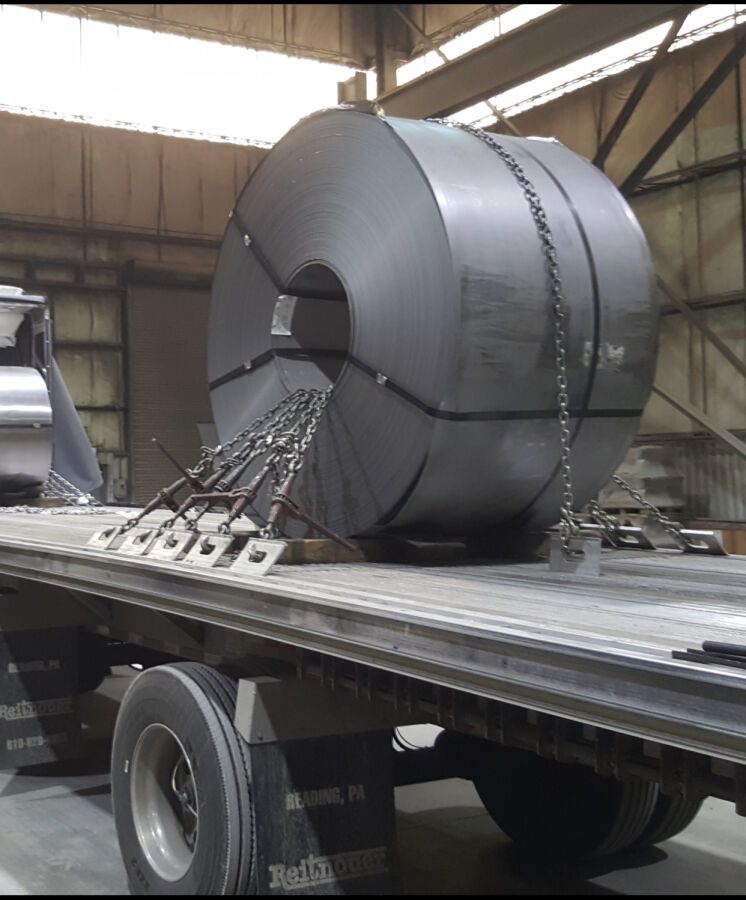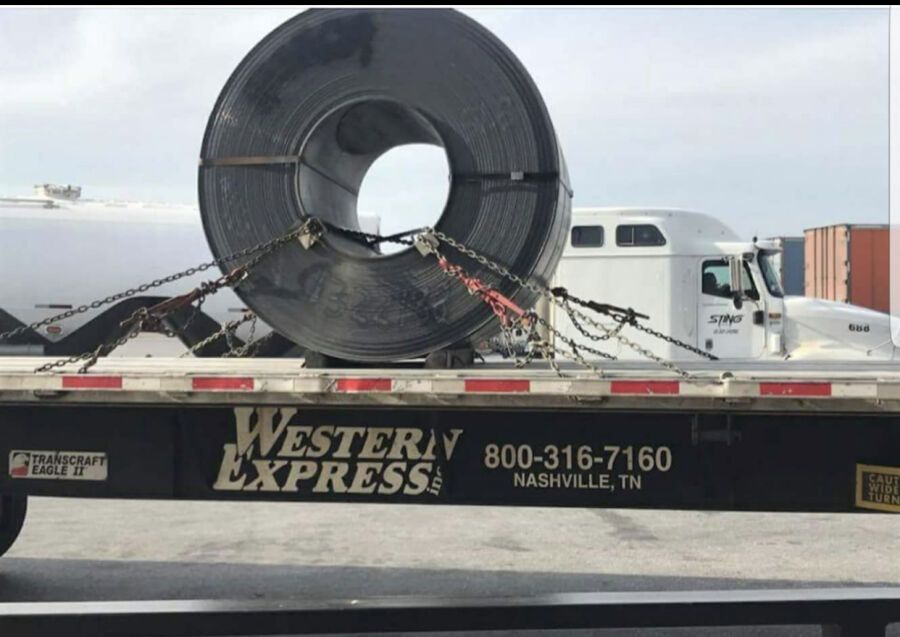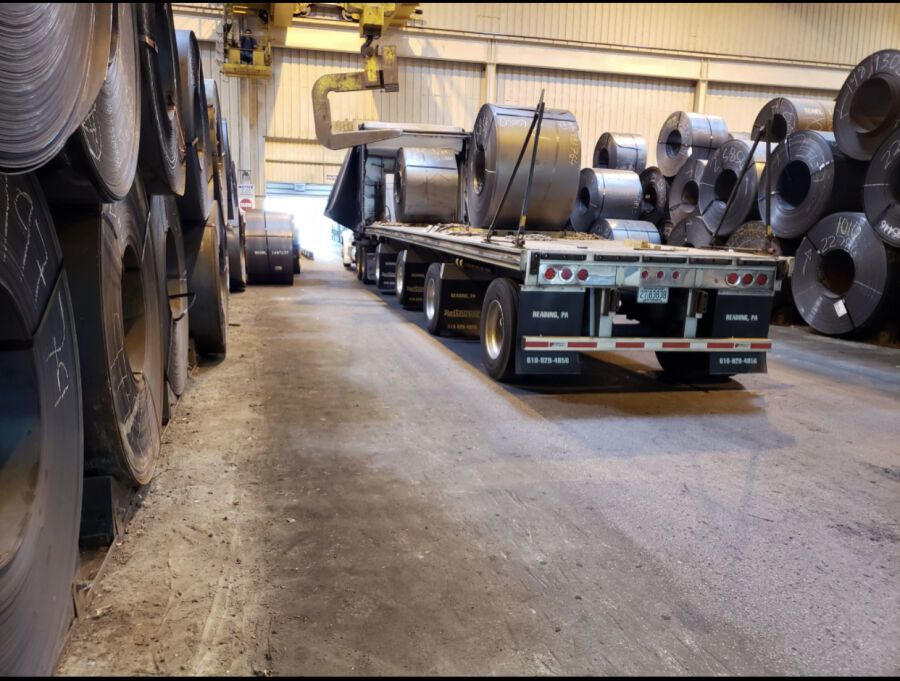Flatbed Securement Discussion 2022
Topic 31351 | Page 2
So how many chains did you put on the coils and how slow or quick did you drive? Some of these cocorners and twists are tight even on a regular freeway or interstate. I drove on a couple of U.S. highways on this load which was 24 west and south and 70 West.
Victor. As a guy who has hauled coils, many of them and very heavy (those two were 84k combined), I can tell you that you’re not going to use a bulkhead. Chaining coils is all about doing it properly and consistently and respecting that load for the potential hazards it poses. A bulkhead made of a few 4x4’s isn’t going to stop a coil if it gets loose, not much will.
Bulkhead:
A strong wall-like structure placed at the front of a flatbed trailer (or on the rear of the tractor) used to protect the driver against shifting cargo during a front-end collision. May also refer to any separator within a dry or liquid trailer (also called a baffle for liquid trailers) used to partition the load.
Interstate:
Commercial trade, business, movement of goods or money, or transportation from one state to another, regulated by the Federal Department Of Transportation (DOT).
HOS:
Hours Of Service
HOS refers to the logbook hours of service regulations.OOS:
When a violation by either a driver or company is confirmed, an out-of-service order removes either the driver or the vehicle from the roadway until the violation is corrected.
Robert B.
Thanks for contributing. It's nice to hear validation of my practice of narrower angles and more downward pressure for my securing coils with chains.
I had a question regarding your 1/2 inch chains, which I assume have a 11,300 lb WLL. What are the options and WLL for tie downs on your trailer.
On our Reitnouer trailers, our the maximum WLL for any tie down is 6,600 lbs. Prime issues 5/16 inch chains with a 4,700 WLL. I bought two 3/8 inch chains (6,600 lb WLL), 25' long and cut them in half. So I have four "short" chains that I use for securing coils, bumping my WLL by almost 4,000 when I use two short chains per coil (my binders are 6,600 lb WLL) when I loop the chain around two spools on the trailer (6,600 WLL). So with two of my short chains and two of the Prime issued chains, I can get an aggregate WLL of 23,000 lbs.
Hey Chief, great question. Those particular trailers were specifically built for heavier applications. 4 axle trailers with the main beams rated at 60 tons. The real limitations were on the securement devices and equipment itself. The chains were rated for 11,300, the binders rated at 12k and the J plates were rated for 11,500. I always shot for close to 100% when hauling coils just to play it safe but bad things can still happen no matter how well we prepare. The one thing I always kept in the back of my head was that I knew I followed my plan and did each coil the same way every time. Oh and I only used 2 chains on each coil. At 20’ length, it was long enough to break the chain and still have enough slack to qualify as 2 independent securement out of one chain. The angles are very important. Every steel and coil hauler I met all said the same thing, keep them tight and keep them inside the dimension of the coil when possible. That way, the coil, no matter the size, can’t get any leverage on movement and it all stays nice and tight. Coils aren’t something to be afraid of, you just have to respect them and treat them nice.
HOS:
Hours Of Service
HOS refers to the logbook hours of service regulations.Got it! So could you send a photo when you do one to demonstrate?
Hey Chief, great question. Those particular trailers were specifically built for heavier applications. 4 axle trailers with the main beams rated at 60 tons. The real limitations were on the securement devices and equipment itself. The chains were rated for 11,300, the binders rated at 12k and the J plates were rated for 11,500. I always shot for close to 100% when hauling coils just to play it safe but bad things can still happen no matter how well we prepare. The one thing I always kept in the back of my head was that I knew I followed my plan and did each coil the same way every time. Oh and I only used 2 chains on each coil. At 20’ length, it was long enough to break the chain and still have enough slack to qualify as 2 independent securement out of one chain. The angles are very important. Every steel and coil hauler I met all said the same thing, keep them tight and keep them inside the dimension of the coil when possible. That way, the coil, no matter the size, can’t get any leverage on movement and it all stays nice and tight. Coils aren’t something to be afraid of, you just have to respect them and treat them nice.
HOS:
Hours Of Service
HOS refers to the logbook hours of service regulations.I don’t do open deck work anymore but let me see if I have more photos I can dig up demonstrating it.


Here’s a couple photos for you. The top one being one of mine. You can see how tight I kept everything, pulling directly down into the trailer as to never give a coil an inch. I’d rather destroy that dunnage pulling down into it, than to have the potential for the coil to roll.
The second photo is how to get yourself killed. That was a driver at a facility I loaded at multiple times a week. Myself and another driver saw this, stopped him and helped him fix it before bad things could happen.
I’ve hauled all sorts of open deck loads but have a bunch of experience with steel, coils and heavy haul doing machinery and equipment.
The second photo is how to get yourself killed.
Sure is. Not only is that dangerous, it is also illegal. The chain angle should not exceed 45°, per regulation.
Could you put more than one chain around a stake pocket or pocket holder? Our trailers dont seem to have the flaps that come up like in the first photo. Thank you for digging that up. We were taught to do the first two shallow and then the rest go out from there outwards.
Here’s a couple photos for you. The top one being one of mine. You can see how tight I kept everything, pulling directly down into the trailer as to never give a coil an inch. I’d rather destroy that dunnage pulling down into it, than to have the potential for the coil to roll.
The second photo is how to get yourself killed. That was a driver at a facility I loaded at multiple times a week. Myself and another driver saw this, stopped him and helped him fix it before bad things could happen.
I’ve hauled all sorts of open deck loads but have a bunch of experience with steel, coils and heavy haul doing machinery and equipment.
So what if you cannot keep them in that anglage? Probably butchered that word 😂. Im not sure if the stakeholders can hold two chains or more.
The second photo is how to get yourself killed.
Sure is. Not only is that dangerous, it is also illegal. The chain angle should not exceed 45°, per regulation.
New Reply:
New! Check out our help videos for a better understanding of our forum features

















Preview:
This topic has the following tags:
Flatbed Load Securement Photos Trailers Trip Planning Truck Driver Safety Truck Driver Training








 TT On Facebook
TT On Facebook
This photo gives a little better idea. I used 4 - 1/2” chains on each coil. 2 right across the middle at very little angle and one pulling to the rear with another pulling forward. The key is keeping those angles very shallow so you’re forcing everything down into the bed and not allowing the coil to get any momentum.
HOS:
Hours Of Service
HOS refers to the logbook hours of service regulations.OWI:
Operating While Intoxicated